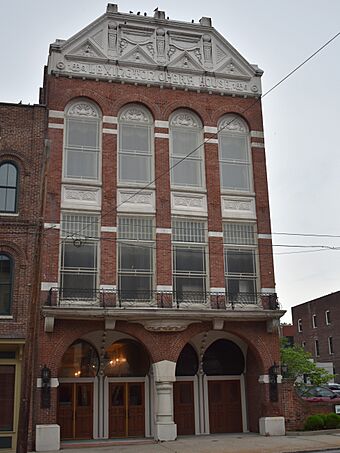Lexington Opera House facts for kids
 |
|
| Address | 401 West Short Street |
|---|---|
| Location | Lexington, Kentucky |
| Coordinates | 38°03′00″N 84°29′56″W / 38.0499°N 84.4990°W |
| Owner | Lexington Center Corporation |
| Type | theatre |
| Capacity | 1,000 |
| Construction | |
| Opened | July 19, 1887 |
| Architect | Oscar Cobb |
The Lexington Opera House is a cool theatre in downtown Lexington, Kentucky. It was built in 1886 after a fire destroyed the old theatre. A famous architect named Oscar Cobb designed this new Opera House. It's so important that it's listed on the National Register of Historic Places.
Today, the Lexington Center Corporation owns and runs it. The Opera House hosts many different shows. You can see ballets, operas, and special shows for kids and families. They also have comedy, music, and big Broadway tours. It's one of only 14 theatres built before 1900 that is still open for live shows!
Contents
History of the Opera House
The Lexington Opera House first opened its doors on July 19, 1887. The very first show was a concert by the Cincinnati Symphony. Soon after, it became very popular in the area. Over the years, many famous performers came to the Opera House. Stars like Al Jolson, W.C. Fields, Will Rogers, and Harry Houdini all performed there.
Amazing Performances
The Opera House was known for its exciting and detailed shows. In 1890, a show called Henley Regatta even flooded the stage! The actors performed in rowboats. In 1893, the Country Circus brought 100 animals for a huge parade. For the play Ben Hur, the stage was changed to have a chariot race.
The Kentucky Equal Rights Association (KERA) also used the Opera House for important meetings. Famous women who fought for equal rights spoke there. These included Rev. Anna Howard Shaw and Emmeline Pankhurst.
Changes Over Time
For about 25 years, the Opera House was a big success. But then, things started to change. Cars, radio, and movies became popular. People started going to live shows less often. This made it hard for the Opera House to make enough money.
The last live show at the Opera House was The Arabian in 1926. After that, it became a movie theatre. They even put in a false ceiling and covered up some fancy parts. Sometimes, other types of shows still happened until 1936.
Saving the Theatre
A man named Price Coomer bought the Opera House in 1955. He worked hard to fix it up. This saved it from being torn down the first time. In 1961, there was a plan to demolish the theatre. But luckily, it was saved again.
Later, in 1968, a big windstorm caused the false ceiling to fall. Then in 1973, another storm made the roof collapse. The building was in bad shape and was just a cheap movie theatre.
People in the community worked together to save the Opera House. They wanted everyone to know how important it was. Experts found that it would be cheaper to fix the old building than to build a new one. So, the city bought the Opera House. Groups like the Opera House Fund, Inc. helped raise money to fix it. This fund was started by people like William T. Young and George and Linda Carey.
The Opera House Fund, Inc. started in 1974. It's a group that helps the Opera House. They bring in professional touring artists for shows like Broadway Live. They also help local performing arts groups.
Architecture and Design
Oscar Cobb from Chicago designed the three-story building. A company from Lexington built it. A skilled stonemason named Henry A. Tandy helped build it. His company also worked on other historic buildings in the city.
Original Features
The theatre originally had seats for 1,250 people. It had two balconies and special box seats on each side of the stage. The stage was very advanced for its time. It had an Edison light board and trap doors. These trap doors allowed animals to be used in shows. To prevent fires, the Opera House had pipes that could flood the stage with water if needed.
The design inside was very detailed. The seats were covered in fancy leather and velvet. Each box seat even had a hat rack and umbrella holder! There were 250 gaslights and many different sets for shows.
Modern Restoration
In 1975, the Lexington Center Corporation started to restore the Opera House. They removed the false ceiling and reopened the balconies. The stage was rebuilt with modern equipment. But the old Edison light board was kept for history. The restoration was finished in 1976.
Now, the theatre has less than 1,000 seats. About 85,000 people visit each year. It's one of the smallest theatres in the country to host big Broadway shows. Its unique 19th-century style makes it a special place. It's still a top spot for culture and history in downtown Lexington.

